Northumberland Coast
This was the coastal route from Scotch Corner to
Edinburgh - 204.6 miles
See http://www.aboutbritain.com/counties/northumberland.asp and http://northumberland-cam.com/castles/index.htm
Scotch Corner
Amble
Alnwick
Seahouses
Bamburgh
Holy Island
Berwick-upon-Tweed
Duns
The City of Edinburgh Bypass
Queensferry
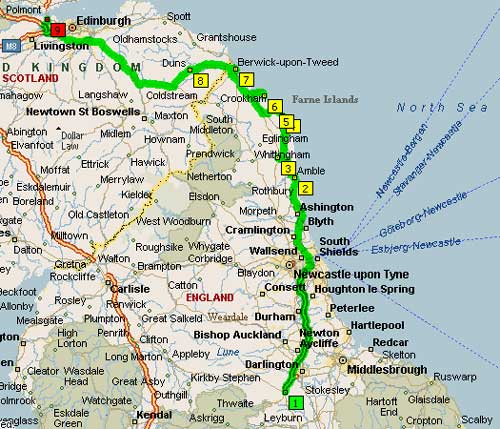
I've added some info about the locations I visited on this trip, along with other sites I've visited on other trips below. For the Google Map, see here. For a Great North Run itenery, see here
wallsend
Wallsend derives its name as the location of the end of Hadrian's Wall. It has a history of shipbuilding and was the home of the Wigham Richardson shipyard, which later amalgamated to form Swan Hunter & Wigham Richardson, probably best known for building the RMS Mauretania, and the RMS Carpathia which rescued the survivors from the Titanic in 1912. WWII ships built here include HMS Sheffield and HMS Victorious which took part in the sinking of the Bismarck. Other ships built there include the new Ark Royal in the 80's. The shipyard closed in 2007. Gordon Matthew Sumner (Sting / The Police) was born in Wallsend.
Whitley Bay
Whitley Bay on the North Sea coast and boasts a stretch of beach of golden sand forming a bay stretching from St. Mary's Island in the north, to Cullercoats in the south. The town became a popular holiday destination for the people of North East England and Scotland & still remains a popular stag/hen night destination.
Whitley Bay was once famous for its permanent seaside fairground The Spanish City, which has now been demolished. A fairground returns to the town on bank holidays, but is now located on 'the Links', an expansive seafront park to the north of the original Spanish City site. The Spanish City Dome, which is a Grade II Listed building, is to become the centrepiece of a multimillion pound "regeneration" of the seafront complex, which will include hotel and leisure developments. The Spanish City is the subject of the Dire Straits (who originated from here) song Tunnel of Love, along with Whitley Bay and the nearby town Cullercoats.
Also in the town is St. Mary's Lighthouse, and Whitley Bay Ice Rink is home of Whitley Warriors Ice Hockey Club. The team enjoyed great success together with local rivals Durham Wasps at a national level during the 1980s and early 1990s.
 TynEmouth Castle
TynEmouth Castle
Tynemouth Castle is located on a rocky headland (known as Pen Bal Crag), overlooking Tynemouth Pier. The moated castle-towers, gatehouse and keep are combined with the ruins of the Benedictine priory where early kings of Northumbria were buried. See http://en.wikipedia.org/wiki/Tynemouth_Castle_and_Priory
Seaton Delaval Hall
Located in Seaton Sluice, Whitley Bay. See http://www.seatondelaval.org.uk/, http://en.wikipedia.org/wiki/Seaton_Delaval_Hall and http://www.nationaltrust.org.uk/main/w-global/w-localtoyou/w-yorkshire_ne/w-seaton_delaval-saveit/w-seaton_delaval-about-2.htm
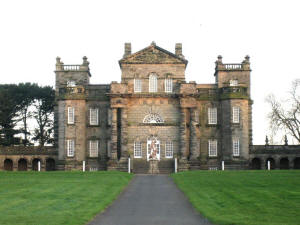 Todays Seaton Delaval Hall was designed by Sir John Vanbrugh; the most famous architect of the 18th century. It was the last country house designed by him & has been described as one of the finest examples of his work and of English Baroque. The building has had a turbulent history of destruction and restoration. The West Wing was originally designed to be part of the servants' accommodation, and has been the inhabited part of the Hall in recent years. The Old Kitchen is an impressive centre piece at the heart of the building, and became the renowned location for 'medieval' banquets in the 1970s and 80s.
Todays Seaton Delaval Hall was designed by Sir John Vanbrugh; the most famous architect of the 18th century. It was the last country house designed by him & has been described as one of the finest examples of his work and of English Baroque. The building has had a turbulent history of destruction and restoration. The West Wing was originally designed to be part of the servants' accommodation, and has been the inhabited part of the Hall in recent years. The Old Kitchen is an impressive centre piece at the heart of the building, and became the renowned location for 'medieval' banquets in the 1970s and 80s.
Amble
Amble grew in the 19thC as collieries were opened, and its then newly built railway links to the Northumberland coalfields made it an ideal centre for the transport and export of coal. The last colliery closed in 2005. Other industries, such as ship building and sea fishing expanded with the growth of the town, making use of the natural harbour that had existed for centuries, still exist on a small scale. Warkworth Castle can be seen from the marina.
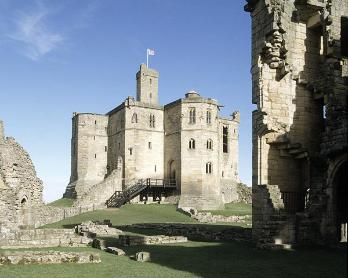 Warkworth, crowning a hilltop rising steeply above the River Coquet, dominates one of the largest, strongest and most impressive fortresses in northern England.
Warkworth, crowning a hilltop rising steeply above the River Coquet, dominates one of the largest, strongest and most impressive fortresses in northern England.
The castle's most famous owners were the Percy family, whose lion badge can be seen carved on many parts of their stronghold.
Half a mile from the castle, tucked away by the Coquet and accessible only by boat, stands a much more peaceful building: the late medieval cave Hermitage and chapel of a solitary holy man.
Alnwick
Alnwick is according to Country Life, October 2002, " the most picturesque market town in Northumberland, and the best place to live in Britain". The town dates back to approximately AD 600, and over the centuries has thrived as an agricultural centre; as the location of Alnwick Castle and home of what were in mediaeval times the most powerful northern barons, the Earls of Northumberland; and as a staging post on the Great North Road between Edinburgh and London.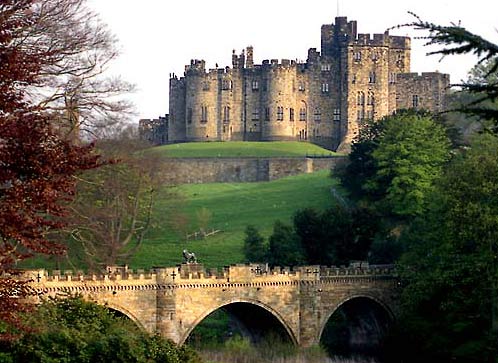
Alnwick Castle dominates the west of the town above the River Aln. The castle is popular with film-makers: Harry Potter; Blackadder and Robin Hood: Prince of Thieves are some of the films shot here. From 1945 to 1975, the castle was the location of a teacher training college for young women and mature students. Currently, it houses American students studying in Europe; is the base of Northumberland Estates, the Duke's commercial enterprise; and is in its own right a tourist attraction.
Hulne Priory, outside the town walls and within Hulne Park, the Duke's walled estate, was a monastery founded in the 13th century by the Carmelites; it is said that the site was chosen for some slight resemblance to Mount Carmel where the order originated. Substantial ruins remain.
Seahouses
Seahouses, known as 'The Gateway to the Farne Islands'. It has an interesting harbour, magnificent beaches and sand dunes stretching for mile-after-mile, to the north and south of the town and with the backdrop of the rolling Cheviot Hills on the distant horizon. Seahouses Harbour also known as 'North Sunderland Harbour', is full of
fishing boats, diving boats, yachts, and pleasure craft.
The current Seahouses lifeboat bears the name Grace Darling, a local heroine known for the daring rescue of survivors of the ship, SS Forfarshire on Big Harcar, a nearby low rocky island in 1838.
Bamburgh
Bamburgh is notable for two reasons: the imposing Bamburgh Castle, an impressive castle that sits on a basalt outcrop overlooking the Farne Islands and Lindisfarne; and its association with the Victorian heroine, Grace Darling (see above).
Its extensive sandy beach was awarded the Blue Flag rural beach award in 2005. The Bamburgh Dunes, an area of sand dunes which are a Site of Special Scientific Interest, stand behind the award winning beach. It's stunning location is often used in car adverts. See http://www.bamburghcastle.com/

Bamburgh Castle
Lindisfarne
Lindisfarne is a tidal island, also known as Holy Island, the name of the civil parish. The name Lindisfarne derives from Farne meaning "retreat" and Lindis, a small tidal river adjacent to the island. A causeway connects the island to the mainland of Northumberland and is flooded twice a day by tides
The monastery of Lindisfarne was founded by Irish born Saint Aidan, who had been sent from Iona off the west coast of Scotland to Northumbria at the request of King Oswald around AD 635 and became a major center of Christianity, learning and artistry, as exemplified by the Lindisfarne Gospels. The monastery had sixteen bishops in all, the most renowned being St Cuthbert, who traveled widely spreading the Gospel and performing healing miracles. After his death the island became a place of pilgrimage, until the monks abandoned the island in fear of marauding Vikings. The priory was re-established in Norman times in 1093 as a Benedictine house and continued until its suppression in 1536 under Henry VIII.
Lindisfarne also has the small Lindisfarne Castle, based on a Tudor fort, built on a volcanic outcrop & refurbished in the Arts and Crafts style by Sir Edwin Lutyens for the editor of Country Life, Edward Hudson. Lutyens also designed the island's Celtic-cross war-memorial on the Heugh.
Large parts of the island, and all of the adjacent intertidal area, are protected as a National Nature Reserve to help safeguard the internationally important wintering bird populations.
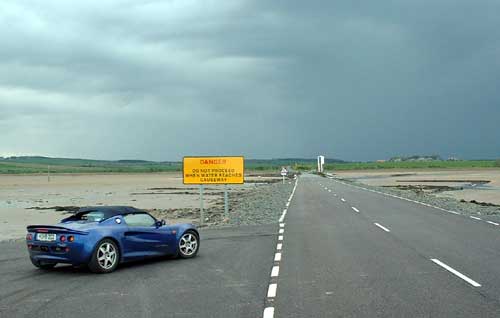
The causway to Lindisfarne (Holy Island)
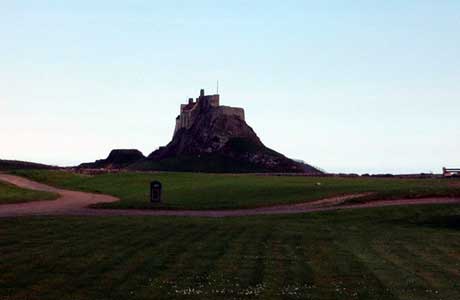
Lindisfarne Castle
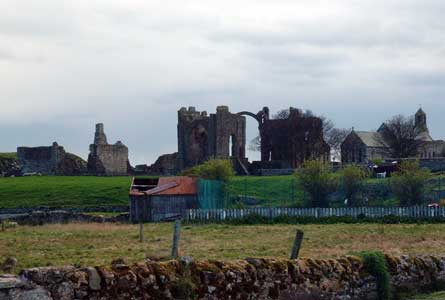
Lindisfarne Priory
Duns
If you're in the area anyway, and interested in Lotus / motor history, a visit to the Jim Clark rooms in Duns is highly recommended. See here for more.

